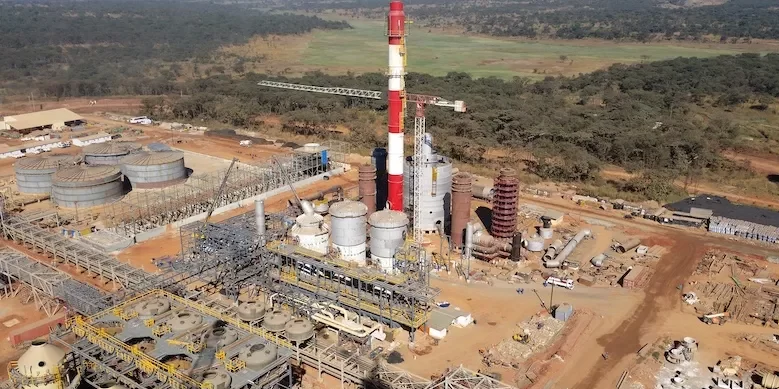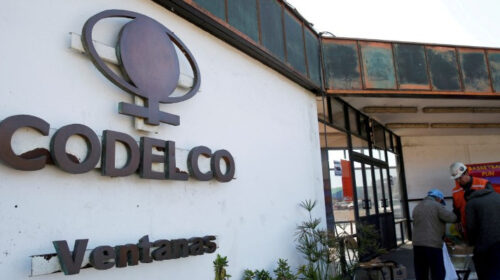Kansanshi Rising: Inside S3 with Anthony Mukutuma
In May 2022, First Quantum Minerals (FQM) reinforced its commitment to Zambia by investing $1.25 billion in an expansion project at Kansanshi, known as the ‘S3 project’.
The project will extend the life of the mine by 20 years, protect thousands of jobs, and ensure that the company’s widespread and varied support for the community can continue.
S3 involves expanding Kansanshi’s mining pit, building a new processing plant, and enlarging the mine’s on-site smelter – all in the name of producing more copper.
Following a conversation with the mine’s General Manager about the personal journey that led him to Kansanshi, Mining For Zambia spoke to Mr Anthony Mukutuma about S3’s progress, and the fact that it’s on track for completion in May 2025.
The S3 project will enable Kansanshi to boost production once again, as the mine transitions from a “high-grade, medium-scale operation to a medium-grade, larger-scale mining operation”.
Once the mining pit has been extended into a new section of the ore body (‘the Southeast Dome deposit’), what will S3 deliver?
The S3 project should take Kansanshi from the 135,000 tonnes of copper that we produced in 2023, to in excess of 250,000 per annum, post expansion.
Because the design of S3’s plant is based on and incorporates learnings from Sentinel and Cobre Panama’s plants, we expect ramp-up to be quick.
Based on the current plan, production for 2025 is expected to be in the 170-200,000 tonne range, ramping up to about 180-210,000 tonnes in 2026. The average ore grade will be 0.58% copper.
What progress have you made with expanding the pit?
We began mining the Southeast Dome in December 2023, starting with bush clearing and topsoil mining. Since then, we’ve been making very good progress, and we’re on track to put ore into the crusher – and start production – in May of 2025.
S3 also involves the construction of a standalone 25-million-tonne per annum processing plant, which is necessary to handle the increased ore volumes. How is that progressing?
Progress has been very good. The civil and concrete works around the primary crusher, the conveyor corridor, the reclaimed stockpiles and the pebble crushers are almost complete, as is the work on the milling and flotation area.
Some of the components (like flotation cells) are coming out of Europe and are being shipped the longer way around [due to conflict in the Suez Canal] so we’re anticipating a slight delay of about two weeks, but nothing significant.
We expect to start the assembly of the mills, flotation cells, and the primary crusher early in the second quarter of this year [Q2 2024].
S3 involves a lot of construction. How many jobs are being created?
So far, about 809 jobs have been created for contractors on the construction side, and that will build up to about 1,800 by Q2 2024. S3 will also create permanent jobs for approximately 800 people – 140 of which have already been recruited, mainly for mining equipment operators.
“So far, about 809 jobs have been created for contractors on the construction side, and that will build up to about 1,800 by Q2 2024. S3 will also create permanent jobs for approximately 800 people – 140 of which have already been recruited.”
Expanding the mining fleet that services the expanded pit is a large portion of FQM’s $1.25 billion investment. Tell us why adding to the fleet is so important.
We need to increase our mining fleet to support mining volume increases of between 25 and 28 million tonnes this year. The amount of material we need to mine will go up by a further 34 million tonnes in 2025. This new equipment needs to be put to work straight away because time is a luxury we don’t have.
The assembly of our new fleet of Hitachi EH4000 dump trucks is progressing at a rate of two to three trucks every month. We ordered 36 trucks and had assembled and commissioned fourteen by the end of last month, so we should be done and dusted by about September.
We also ordered six shovels (loading units similar to excavators), two of which have been assembled, with a third in assembly and due to be completed by the end of this month.
Kansanshi makes use of an extensive network of ‘electric trolley assist’ infrastructure which aids trucks’ movement on site by connecting them to an electrified trolley system, slashing carbon emissions.
Tell us about other energy-saving equipment that’s being put to use at S3.
The Hitachi EH4000 dump trucks I mentioned are diesel-electric trucks, which will significantly reduce carbon emissions. Although this fleet is new, we’ve been using diesel-electric trucks at Kansanshi for several years.
Most of the trolleys are used to assist trucks uphill, but we’ve now got trolleys in some flat parts of the pit for increased productivity and reduced emissions. The flat trolley is also in preparation for bringing in a fully electric dump truck for heavy duty mining operations.
Tell us about these fully electric trucks.
We are collaborating with Hitachi to test a battery electric truck that they have been developing. This prototype, which has already undergone initial in-factory testing, is on its way to Kansanshi Mine, where final testing will be done in mid-2024.
The truck won’t need to stop and charge (as battery electric vehicles usually do) because it can use the existing trolley lines at Kansanshi to charge while in motion, with no impact on productivity.
Cutting-edge technology clearly plays a big role at Kansanshi. Tell us about some of the other technological advances that will be introduced at S3.
To start with, all our drills are now fitted with high precision GPS devices. In the past, surveyors would put pegs on drill patterns to guide drill rigs.
Now, GPS information is fed into the drill so the drill operator can just move the rig and the technology knows where the next drilling position is. This has major safety benefits, with less people on the pit floor, and it also increases productivity.
We’re using an FQM-developed Artificial Intelligence (AI) agent at Sentinel and Kansanshi. It’s called Quantum Blast Intelligence (QBI).
It has AI algorithms that run when we do a blast, so we can predict blast movement. The agent is always learning so, over time, we can predict blast movement better and, ultimately, know where the low grade and high grade ore goes, so we can take certain grades straight to the crusher.
Innovation is always front and centre of everything we do at FQM. For instance, we’re exploring technology with a company called Nextore, which has developed conveyor scanners and, most recently, a truck scanner to determine copper content on trucks.
“The Government of Zambia is very serious about adding value to minerals in-country, and our smelter is a significant step towards those goals.
Without sufficient smelting capacity, the alternative is to ship concentrate all the way to smelters in Europe or the Far East. That would mean that the 960 people that permanently work at the smelter wouldn’t have a job here.”
S3 includes a $115 million investment to enlarge Kansanshi’s state-of- the-art smelter. What is the significance of having a smelter on-site?
The Government of Zambia is very serious about adding value to minerals in-country, and our smelter is a significant step towards those goals.
The product that comes out of the smelter is 98% pure copper. Without sufficient smelting capacity, the alternative is to ship concentrate (which is only 25% pure copper) all the way to smelters in Europe or the Far East.
That would mean that the 960 people that permanently work at the smelter wouldn’t have a job here – those jobs would be created in other countries.
Shipping 98% copper [compared to 25% copper] also has huge cost savings for us as a business, plus it greatly reduces our carbon footprint.
How urgent is the need for increased smelter capacity?
Smelting capacity in Zambia and the region – including the DRC – is limited. We get people knocking on our door every day to ask us to treat their concentrate here, but our capacity is filled by Sentinel and Kansanshi.
So it’s important that, as copper production at Kansanshi goes up to in excess of 250,000 tonnes a year, there is smelting capacity available at Kansanshi.
The expansion to the smelter will need to be connected into the existing plant. We plan to time that with the smelter’s next four-yearly shutdown in June 2025, which is a standard practice that allows us to refurbish the furnaces, and so on.
The $1.25 billion going into S3 is the largest investment in Zambia’s mining industry in recent years. What impact will it have on the economy?
Increasing the number of jobs at Kansanshi will have economic spin-off effects, like down-the-chain employment and increased household spend.
Once we get back to producing in excess of 250,000 tonnes of copper per year, the royalties we pay will be significantly higher than in years when we produced 130-150,000 tonnes. So, it will also mean increased taxes to Zambia.
Crucially, the S3 expansion means that the future of Kansanshi is secure because we’ll now have a mine that’s viable for over 20 years.
If we didn’t do this expansion, Kansanshi would be running cash negative in some years, and we’d either have to shut it down or scale it down into a very, very small operation.
At the moment, we support schools, we run scholarships, and making a positive impact on lives and livelihoods is very important to us.
All that would have to be scaled down until we were nothing more than a mine – just plain vanilla. And that’s not Kansanshi’s – or FQM’s – identity. It’s never been purely mining.
Kansanshi runs a large number of programmes in the community, from extending support to tens of thousands of farmers, to training groups of vulnerable women to become jewellery makers in a dedicated workshop. Which are you particularly proud of?
If I had to choose one initiative, it’d be the work we do in education: from early childhood education, and into primary, secondary and university scholarships.
Every single year we give 12 scholarships to students from across Zambia to do A-levels and, once they finish, we sponsor them through university.
Some of the students that come out of this programme end up working on the mine, but we don’t bond them in any way, and others end up studying for postgraduate degrees on other scholarships in Europe or the US.
A scholarship from A-levels to university is basically the way I started out, so being a part of this initiative, and seeing First Quantum close that loop is something that I’m really proud of.
I’m also very proud of the work we’re doing for the town of Solwezi itself. We have been working with the Solwezi Municipal Council on township roads for over eight years.
When we started construction of around four kilometres of roads in the township last year, I said, “We are going to build us a city in Solwezi.”
I think it’s work like this that sets us apart from mining companies that go in, mine, and walk away. Responsible mining is very important to us and I am privileged to be part of a company that has responsible mining in their DNA, and lives by this every day.
331 total views , 1 views today





